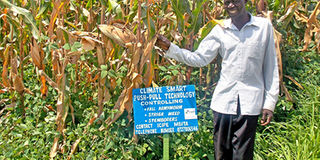Easy way to protect maize plants from stem borers

Maize farmer, Reuben Onyango, who practices the push-pull technology in his farm in Mbita pictured here in the farm in this past photo. The technology is appropriate to smallholder mixed-cropping systems in Africa. PHOTO | FILE | NATION MEDIA GROUP
What you need to know:
- Several approaches have been advanced to manage these two challenges, among them the use of push-pull technology, which has helped farmers get good results.
- On the other hand, desmodium root exudates chemicals that cause abortive germination of the parasitic weed, thereby effectively reducing the number of seed added to the soil banks by the shoots that will have otherwise emerged reducing the striga seeds in the soil.
- Thus, desmodium intercropped with maize repels the striga pest from the crop (push). Further, desmodium also improves soil fertility through nitrogen fixation, natural mulching and improved biomass produced by the legume also controls soil erosion.
- Overall in areas where this technology has been adopted, soil health has improved as a result of nitrogen-fixation by desmodium, increased organic matter and soil moisture conservation.
It is another planting season and as farmers rush to plant their maize and beans, some of the weeds and pests they will battling with are striga (striga hermonthica) and stem borer.
Striga, also called witchweed, is a serious constrain to maize production in western Kenya, especially when susceptible varieties are grown. On the other hand, stem borer affects maize across the country, causing huge losses to farmers.
Several approaches have been advanced to manage these two challenges, among them the use of push-pull technology, which has helped farmers get good results.
Push-pull technology was developed by the International Centre of Insect Physiology and Ecology (Icipe), Rothamsted Research (UK) and other partners for integrated pest, weed and soil management in cereal-livestock production systems.
Under this method, stem borers are attracted by napier grass that is planted on the border of the field as a trap plant (pull).
The napier grass produces significantly higher levels of green leaf volatile cues (chemicals) used by stem borer females to locate host plants other than sorghum and maize for ovipositing. Moths lay more eggs on the trap crop because it releases more attractive chemicals than the main cereal crop.
However, once the eggs hatch, most of the stem borer larvae do not survive because napier grass foliar tissue produces sticky sap (in response to their feeding), which traps and kills them. Desmodium fodder crop intercropped with maize acts as a repellent that pushes them away.
On the other hand, desmodium root exudates chemicals that cause abortive germination of the parasitic weed, thereby effectively reducing the number of seed added to the soil banks by the shoots that will have otherwise emerged reducing the striga seeds in the soil.
IMPROVED SOIL HEALTH
Thus, desmodium intercropped with maize repels the striga pest from the crop (push). Further, desmodium also improves soil fertility through nitrogen fixation, natural mulching and improved biomass produced by the legume also controls soil erosion.
Both companion plants provide high-value animal fodder, facilitating milk production that improves farmer’s income.
The technology is appropriate to smallholder mixed-cropping systems in Africa. It effectively tremendously improves maize yields from below 1t/ha to 3.5t/ha, and it is economical to resource-poor farmers as it is based on locally available plants, not expensive external inputs.
Overall in areas where this technology has been adopted, soil health has improved as a result of nitrogen-fixation by desmodium, increased organic matter and soil moisture conservation.
Ecologically, the technology has enhanced soil biodiversity, thereby further improving soil health and fertility.
Additionally, because desmodium provides ground cover, it leads to reduced soil temperatures and together with surrounding napier grass, protects the soil against erosion.
Farms under push-pull are therefore sustainable and resilient, with improved potential to mitigate the effects of climate change.
Both desmodium and napier grass grown perennially, continually provide valuable year-round quality animal fodder while the sale of desmodium seeds generates additional income to farmers.
Farmers in the striga-prone areas of western Kenya are urged to adopt this technology for climate-resilience and improved food security.
****
Get it fast
The simple technology
- Under this technology, desmodium should be planted in such a way that its rows alternate with maize so that ploughing the field in the next season will be easy.
- Plant the maize in the field already surrounded by napier grass. Ensure that the first row of maize is one metre away from the napier grass. The recommended spacing for maize is 75cm between rows.




